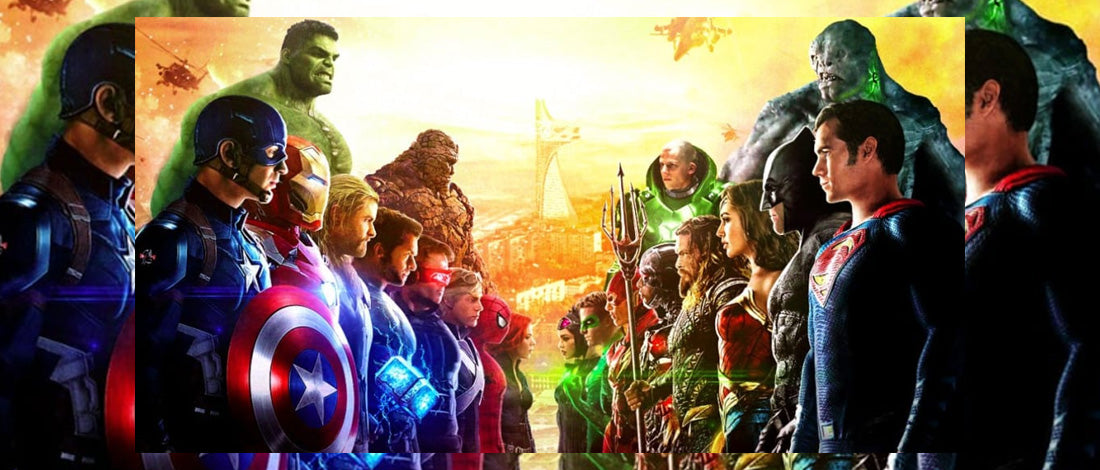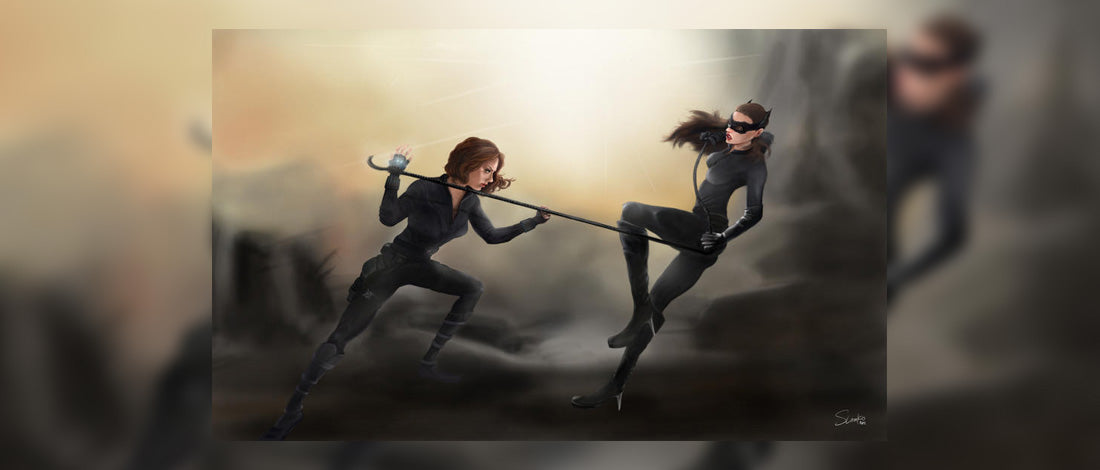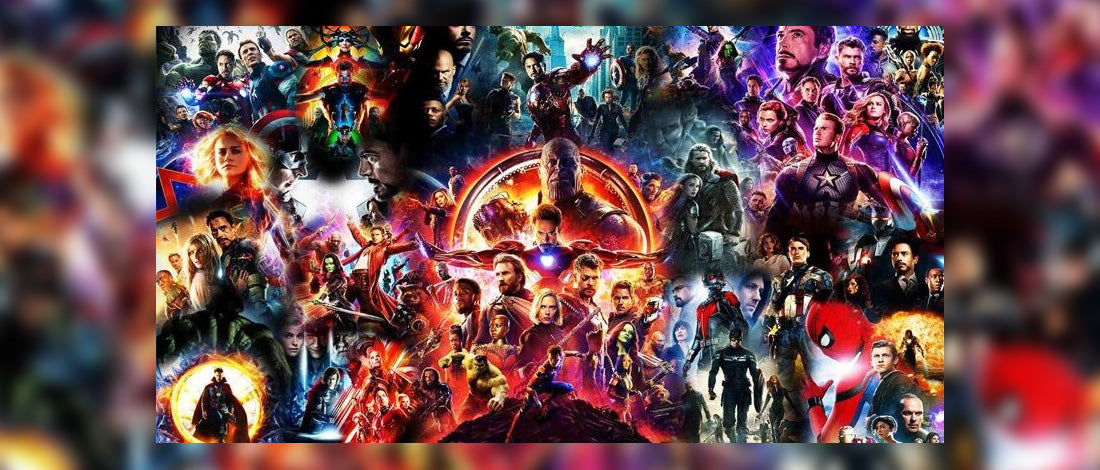If you’re a huge fan of superhero movies, you may have heard Marvel vs DC pitted against one another at some point.
Well, we’re here to settle the score once and for all. We’ll dive deep into the franchises’ themes, their similarities and differences, and which franchise ultimately has the best heroes.
Here’s the rundown on the Marvel vs DC showdown.
DC vs Marvel

Marvel and DC both have their cult followings and have become pop culture icons over the past few years. The inception of these two universes goes as far back as the 1900s, during the Golden and Silver Ages of Comic Books. How many times have you heard a duo referring to themselves as “Batman and Robin” or that someone turned so green and angry, it was a surprise that they didn’t turn into “the Hulk?”
And while, sure, both the Marvel and DC universes may be stories about a band of iconic heroes and their adventures (or misadventures), we’re sure you’d get beaten to a pulp as soon as you utter the darned words: “They’re basically the same.”
Superhero movies have become all the rage over the past decade, and you may be wondering why Marvel movies have no problem dominating the box office while DC movies struggle with gaining traction. (And even if they do get reviews, they’re not usually positive.) So how come Marvel seemingly knows the secret sauce to make their films stand out, but DC can’t even get their recipe right?
Here is an in-depth look at both the DC and Marvel universes and their similarities and differences.
How Marvel and DC Started
Marvel

Marvel Comics was first published in 1939, during the Golden Age of the comic industry, by a magazine publisher named Martin Goodman. It was first called Timely Comics and featured Human Torch, Angel, and Namor, the Sub-Mariner. The comics sold 80,000 copies. In 1941, Captain America was introduced as one of the first patriotically themed superheroes in history.
Stan Lee was only 16 years old when he started working for the publication as a general office assistant and eventually became editor. He wrote extensively and contributed to plenty of titles.
In the 1950s, the brand noticed that the superhero trope was falling out of style. So they expanded into a wider variety of genres, including horror, humor, talking animals, romance, crime, and war comics.
At the turn of the decade, though, they noticed that their biggest competitor DC Comics (known then as National Comics Publications), was getting traction with their Superman, Flash, Green Lantern, and Wonder Woman characters. So they took inspiration and followed suit. They rebranded their superheroes and introduced characters that would appeal to older audiences, which they eventually called Marvel Age of Comics. They debuted with the Fantastic Four.
Timely Publications changed its name to Atlas Magazines, and eventually to Marvel Comic in the 1960s.
DC

DC Comics was first released in 1934, making it five years older than Marvel. It was first published under National Allied Publications. It was changed to DC Comics much later in 1977, whose inspiration came from their popular series Detective Comics, which featured Batman.
Its first publications were New Fun Comics and Adventure Comics in 1935, Detective Comics with Batman in 1937, and Action Comics with Superman in 1938.
In the mid-1950s, during what is known as the Silver Age of Comic Books, they decided to revive Flash, one of their old characters. They reinvented the speedster and gave him a better identity as a civilian, a “flashier” costume, and a science-fiction origin story. He proved sufficiently popular to the audience that they revamped most of their older characters, including Green Lantern, Superman, Wonder Woman, Aquaman, and the rest of the Justice League of America.
Read: Who Owns DC Comics?
Marvel and DC Themes and Characters
Marvel
If you look at the central theme of Marvel comics, you will likely notice that the superheroes you look up to come from ordinary people like you and me. They have innate flaws, fears, hopes, and dreams before being subjected to gamma rays or other freak occurrences that grant them their powers.
Peter Parker was just a regular high school kid when a radioactive spider bites him on a class field trip. He calls himself Spider-Man and now has superhuman abilities. He takes care of the citizens of New York, all while trying to get good grades in school and staying out of trouble.
Ultimately, Marvel brings its characters’ humanness to the forefront. Just like us, we see them striving to be good people while trying to control their powers. The comic book characters are not exempt from making mistakes, making them relatable.
DC
Most of DC’s characters are born great and come from far away planets. They are often bestowed with great powers since birth. This makes them all-powerful and elevates them above normal humans. Their storylines are always about protecting the innocent from the evildoers and exhibiting perfect, positive qualities.
Although we get it — DC comics characters are godlike and perfect, and it’s mostly just a fantasy world, but it makes us think that the only way we can be considered good people is if we were perfect, too.
Shop The DC Justice League Collection NowMarvel and DC Notable Differences

Franchises
The DC universe relies heavily on their superheroes’ identities. This is visible in the obvious dichotomy between Superman and Batman fans. Each of the films in the franchise also feels distinctly different from one another as many of the films’ directors take artistic liberty. The entire franchise is also geared towards an older audience, as they deal with much more complex issues like prostitution, abuse, and mental health.
The Marvel franchise is undoubtedly more popular than DC. Marvel fans are religious followers of the franchise itself, never mind that each movie tells the story of a different character. You wouldn’t see fans fighting heatedly over whether Iron Man is better than Captain America because the fans love the heroes individually.
Movies
2008 was a glorious year for both high-grossing franchises as two films from the respective universes came out on the silver screen (DC’s The Dark Knight and Marvel’s Iron Man).
A central theme in DC movies is darkness, both literally and figuratively. There is no doubt that the movies are visually stunning, but the scenes are encased in so much darkness that it’s hard to figure out what’s happening at times. And don’t even get us started on the movie themes and characters — Joaquin Phoenix’s interpretation of the Joker, while brilliant, left us shuddering.
The most popular DC movie to date is still The Dark Knight trilogy, directed by Christopher Nolan. It starred Christian Bale and Heath Ledger — however, these movies are not even technically part of the DCEU (DC Extended Universe). [1]
The Marvel Cinematic Universe is colorful, fun, and bright, thanks to Kevin Fiege, the president of Marvel Studios, and his signature touch. The movies are not afraid to take themselves lightly, with Guardians of the Galaxy and Thor coming to mind in terms of comedic relief. There is an air of child-like innocence as soon as the film opens, and there is linearity in all of the films — you wouldn’t have to guess that you’re watching a Marvel movie.
Robert Downey, Jr. played Tony Stark in 2008 so well that he became a household name, despite Iron Man not having a particularly strong following before the movies. The Marvel movies also touch on pretty heavy human subjects, such as loss, self-doubt, and despair, which leaves us wanting to offer the superheroes a shoulder to cry on.
Location
DC comics cities like Gotham City, Smallville, and Metropolis are pure fiction, but they are supposedly prominent cities in the United States in the comics universe.
Their idea of going this route was that they wanted the readers to feel like the cities mentioned in the fantasy comics could be anywhere — even the next city.
Marvel uses plenty of real locations, with New York City, Houston, and Los Angeles being the most prominent. While the landmarks featured are fiction (the last time we checked, there was no Avengers Headquarters nor a Daily Bugle publication in New York), it makes the fans feel as though they might just encounter their favorite Marvel superheroes if they look hard enough.
Comics
In DC comics, superpowers are highly accepted. In fact, DC heroes like the Man of Steel and Wonder Woman are highly adored and revered by the public for their great power. They are seen as beacons of light who have come to protect them from the bad guys and save the day.
On the other hand, the public is not as welcoming of mutants in Marvel comics. Some Marvel characters are seen as freaks of nature (X-men, Scarlet Witch, and the Bruce Banner are a few examples). This leaves our heroes with a lot of self-doubt and distrust.
Universe

In the make-believe universe of DC comics, they explored the fantasy of living a life with inborn superpowers, good qualities, and having people look up to you and adore you. DC’s heroes didn’t just have mere superpowers; they were powers that extended far beyond what you can imagine.
In the Marvel universe, our favorite heroes are real people experiencing real issues in life. They go through and struggle with everyday motions just like you and me — work, school, and relationships — but they are dealt with the additional responsibility of having powers.
Also Read: Our Favorite DC Comics Gifts
Superheroes
The superheroes in the DC universe are the modern counterparts of mythical gods. Superman is thought of as a savior who can do no wrong and is the most powerful in the entire universe. Wonder Woman is born out of clay and was brought to life by the ancient Greek gods, granting her godlike strength and invulnerability.
In Marvel, the superheroes are mere mortals who get into some kind of freak accident that involves radiation exposure. Some wake up with powers they don’t want at first, but learn to control over time.
Steve Rogers was just a man enlisting to the army when he got injected with the super-soldier serum. It was initially a super-soldier program for World War II, but as Steve was the only one injected, he became a secret soldier and eventually Captain America. On the other hand, Doctor Strange is an arrogant neurosurgeon who learns about mysticism and magic when he loses his dexterity.
FAQs
Between Marvel and DC, who has the strongest heroes?
Fans of both Marvel and DC have argued plenty of times over which franchise ultimately has the strongest heroes. Both franchises have special heroes that bring something different to the table, and neither scale is tipped significantly more in favor of the other.
We can, however, commend the camaraderie that is present in the Avengers lineup more than the Justice League of America. The DC universe characters often make it seem like they would rather fight alone. More on Avengers vs Justice League here!
Did Marvel copy DC?
Both Marvel and DC have ripped each other off many times. Marvel did take note of a few DC comics concepts but put their personal twist on them. You’ll also likely notice a few counterparts when you take a closer look at each characters — for example, Namor could very well be Aquaman, Bumblebee could be Wasp, and Green Arrow could be Hawkeye.
Battle of Franchises
We’ve reached the end of Marvel vs DC! Ultimately, though, the franchise you choose boils down to your personal preference. You may favor the lighthearted approach of the Marvel franchise or the dark and gritty backstories of DC characters. There is no absolute winner to the Marvel vs DC battle.
If you need some Marvel merch, check out our listings.
Shop The Marvel Collection NowReference:
- https://www.comingsoon.net/movies/news/1188579-dc-dark-knight-trilogy-dceu




